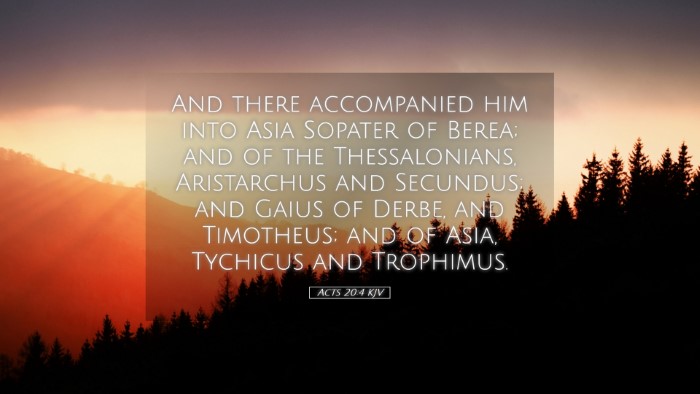Commentary on Acts 20:4
Acts 20:4 states, “And there accompanied him into Asia Sopater of Berea; and of the Thesalonian Aristarchus and Secundus; and Gaius of Derbe, and Timotheus; and of Asia Tychicus and Trophimus.” This verse is a brief yet significant mention of several individuals who accompanied the Apostle Paul on his journey. By exploring the names mentioned and their implications, we can gain deeper insights into early Christian fellowship and ministry. Below are reflections drawn from various public domain commentaries.
Contextual Background
Understanding the context in which this verse appears is crucial. Paul is preparing to leave for Jerusalem, facing the possibility of persecution and trials (Acts 20:22-24). This journey underscores the communal aspect of Christian ministry, where individuals from different regions and backgrounds unite in purpose.
Examination of Individuals Mentioned
The verse mentions specific individuals who accompanied Paul, highlighting the diversity and unity of the early church.
-
Sopater of Berea: According to Matthew Henry, Sopater’s inclusion reflects the participation of the Bereans who were known for their noble character and willingness to verify the teachings they received (Acts 17:11). This points to the importance of discernment in ministry.
-
Aristarchus and Secundus from Thessalonica: Albert Barnes remarks that Aristarchus was a companion and fellow laborer of Paul, facing persecution along with him (Acts 19:29; Colossians 4:10). Secundus, likely a Gentile, symbolizes the expansion of the church beyond Jewish boundaries.
-
Gaius of Derbe: Gaius represents the success of Paul’s ministry in establishing churches in Asia Minor. Adam Clarke notes that he might be the same Gaius mentioned in Romans 16:23, suggesting his prominent role in the early church.
-
Timotheus (Timothy): A young but significant figure in early Christianity, Timothy’s accompanying Paul highlights his development as a future leader (1 Timothy 1:2). His presence denotes both loyalty and the transfer of knowledge from Paul to the next generation.
-
Tychicus and Trophimus of Asia: Tychicus is often seen as a messenger and comforter (Ephesians 6:21), and Trophimus symbolizes the blend of Jewish and Gentile believers. Their shared journey with Paul emphasizes the collective strength found in Christian fellowship.
The Significance of Fellowship in Ministry
The selection of companions emphasizes the biblical theme of fellowship. This communal aspect is pivotal for ministry effectiveness. Matthew Henry states that no one is called to serve God in isolation. Paul’s companions serve as a model for believers today to engage in mutual support and collaboration.
Lessons for Modern Believers
As we interpret Acts 20:4 for contemporary application, several themes emerge:
-
The Importance of Diverse Gifts: Each individual mentioned brought unique gifts and perspectives to Paul’s mission. Just as in the early church, modern congregations thrive through diverse contributions (1 Corinthians 12:12-27).
-
Commitment to the Gospel: The courage displayed by Paul’s companions in the face of potential persecution serves as an inspiration for believers to remain steadfast in sharing their faith, regardless of opposition.
-
The Role of Mentorship: Timothy’s inclusion underlines the necessity of mentorship in faith development. As Paul invested in Timothy, modern leaders are called to nurture the next generation of believers (2 Timothy 2:2).
Conclusion
The brief mention of the companions of Paul in Acts 20:4 reveals much about the nature of early Christian community life. This verse encapsulates the essence of collaborative ministry, diverse backgrounds, and the essence of fellowship amongst believers. In studying this passage, pastors, students, theologians, and Bible scholars gain insights into the early church's structure and the enduring principles that guide Christian ministry today.
References from Commentators
- Matthew Henry - "Commentary on the Whole Bible."
- Albert Barnes - "Barnes' Notes on the New Testament."
- Adam Clarke - "Clarke's Commentary on the Bible."


